
by
John McGregor
~~~~~~~
Over the years, I have seen Steinzeug (salt-glazed
stoneware), called Steingut, Majolica, even Hafnerware, which of course are all
earthenware. It is common to see Feinsteinzeug, another earthenware, identified
as either Porcelain, or Stoneware. Germans seem to confuse Steingut and
Steinzeug and in the U.S., even professionals resort to using the generic term
"pottery" in order to avoid having to use specific terms.
You do not see coin collectors confusing Gold, Silver, or
Copper, or using the generic term "metal" and they are no smarter than
the average stein collector, so why is it so difficult to identify Stoneware,
Earthenware or Porcelain? The whole thing is really very simple and perhaps the
following will help. Let's start with some basic definitions.
CERAMIC: The broad term for all objects made of fired
clay. The principle divisions are earthenware, stoneware and porcelain.
POTTERY: A generic term for all ceramic wares without
exception, but in normal use it is used to designate all wares which are not
porcelain.
~~~~~~~
EARTHENWARE: Objects made of earthenware are not
fused, sintered, or vitrified, meaning they are porous and therefore require a
glaze if they are to hold liquids. Most earthenware products are fired at 900 to
1000 deg. centigrade. Some examples are: Steingut, Faience, Majolica, Deftware,
Hafnerware, Terracotta, Terra Sigillata and Feinsteinzeug. Soft-paste Porcelain
which is made from white clay and glass frit, is not vitrified, so is
technically an earthenware but, because it isn't used in the manufacture of beer
steins, it will be of no further concern to us.
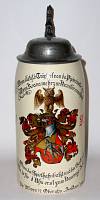 |
Steingut: Steingut is the German equivalent of English
"Creamware." I know of two, possibly three, manufacturers, H. Waffler
of Regensburg who apparently acquired the assets of Fritz Thenn in 1886 and
produced steingut using some of the Thenn molds and the Dorfners of Hirschau.
According to Kirsner's "Beer Stein Book" the
Gebruder Dorfner were in business from 1895 to 1914. Ernst Dorfner was
definitely in business in 1903, suggesting that they were in fact, separate
companies. Glaze colors varied from white to light beige, imitating both
porcelain and ivory stoneware. |
 |
Faience: Faience, or Fayence in Germany , is tin
glazed earthenware, especially that made in France, Germany and Scandinavia. The
term is of French derivation and probably comes from the 16th century popularity
in France of wares made in Faenza, Italy. The technique is exactly the same as
Majolica and Delft, the only difference is the place of origin. |
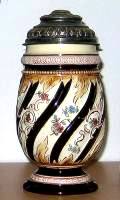 |
Maiolica: Maiolica, or in Germany Majolica, is a term
that originated in Italy for the opaque, tin glazed wares of Valencia, which
came to Italy through the island of Maiorca, now Majorca. Use of the term should
properly be limited to wares of Italy. The technique as mentioned above is
exactly the same for Delft and Faience. |
 |
Delft: Delftware, is tin glazed earthenware that
originated in Delft, Holland. Delftware is also made in England and Germany
where it was introduced by immigrant Dutch potters. Interestingly, the rise of
the industry at Delft took place in the middle of the 17th century, when potters
took over many of the Delft breweries as a consequence of the decline in the
brewing industry. See, Faience and Maiolica. |
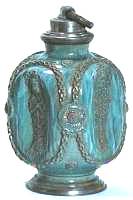 |
Hafnerware: Hafnerware consists mainly of lead glazed
tiles used in stove construction in Germany and the Alpine areas of Central
Europe. Colors are basically limited to greens, browns and yellow. Silesian
Hafnerware with tin glazes, made by the Hafner (or stove) potters, had designs
cut with a knife to prevent the intermingling of the tin glazes employed. Other
wares made by the Hafnerware potters included jugs and dishes. |
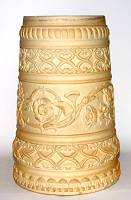 |
Terracotta: Terracotta is usually found without a
glaze, made of redish clay and lightly fired. Figures of Terracotta were usually
the work of sculptors rather than potters. Terracottas are often single pieces
made in a "waste-mold", or reproduced in very limited quantities in a
"piece-mold." The illustrated piece is model 9712 by Johann Maresch.
This particular piece is also found painted in full color. |
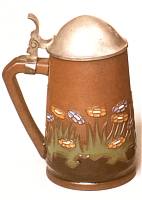 |
Terra Sigillata: Terra Sigillata was originally ware
made from allegedly medicinal clay from Samos and Lemnos and stamped with a seal
(sigillum) of authenticity. Later the term was applied to Arretine and Samian
ware, and more recently to a grey Maltese pottery and to Silesian red ware. It
was also the name given to a line of red ware produced by Duemler & Breiden
around 1910 as evidenced by the example. |
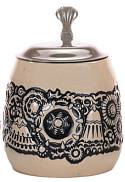 |
Feinsteinzeug: Feinsteinzeug! Never was there a
greater misnomer. Feinsteinzeug is not Steinzeug (stoneware) at all, but
earthenware and it requires a glaze if it is to hold liquids. Feinsteinzeug was
developed to replace the more expensive to produce Steinzeug and
Elfenbeinsteinzeug. It came into general usage around 1910. Most common under
glazes are white, grey and light beige, imitating Porcelain, Steinzeug and
Elfenbeinsteinzeug. |
~~~~~~~
STONEWARE: These objects are fully vitrified and do
not require a glaze to hold liquids. Most stoneware products are fired at 1100
to 1300 deg. centigrade. Examples are, Steinzeug (stoneware, usually salt
glazed) and Elfenbeinsteinzeug (Ivory Stoneware).
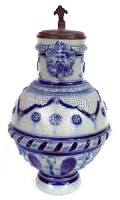 |
Steinzeug: Stoneware clays are found in a narrow band
across north central Europe from Raeren in the west to Bunzlau in the east.
Colors of the clay range from white to dark brown. Steinzeug was first produced
around 1325 and salt glazing soon followed. The jug illustrated was produced
around 1880 in Freising, Bavaria, from Westerwald clay and is in the style of
Raeren. |
 |
Elfenbeinsteinzeug: Elfenbeinsteinzeug is made from
exactly the same clay as Steinzeug, but is fired in a vented kiln which allows
oxygen to enter the kiln during the process that oxidizes the small amount of
iron in the clay causing the beige or ivory coloration. Rather than being salt
glazed, Elfenbeinsteinzeug is covered with a glass frit glaze, safer for the
environment and those who produce it. |
~~~~~~~
PORCELAIN: Porcelain falls into three categories,
Hard-paste, Bone China and Soft-paste which is not really porcelain (see
earthenware). Porcelain is fully vitrified and only requires a glaze for
aesthetic purposes. Most porcelain products are fired at 1250 to 1450 deg.
centigrade. Bone china, while fully vitrified, is less durable than Hard-paste
porcelain as it has had bone ash added to improve translucence and was/is
generally the material of choice of American porcelain factories.
 |
Porcelain: Porcelain has been around since about 700
A.D. when the Chinese first produced it. It took another 1,000 years for
Europeans to discover the secret of its composition. The first European
Porcelain was produced in Meissen in 1708. Most people can identify porcelain
without a problem, but there have been cases of Hauber & Reuther porcelain
being confused with Elfenbeinsteinzeug due to the browns and tans HR used to
decorate much of their porcelain, which is often etched, or in threaded relief,
thus adding to the confusion. |
|










